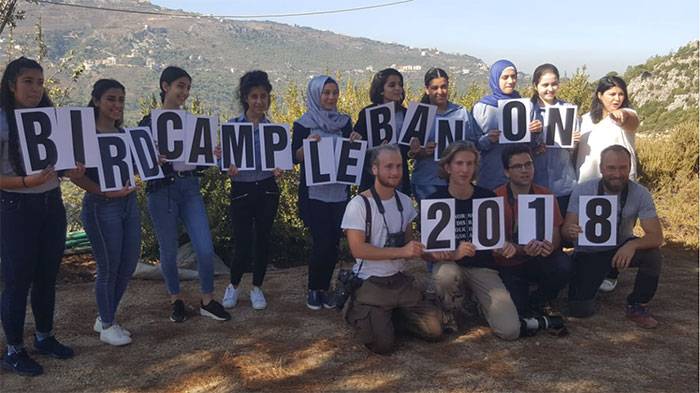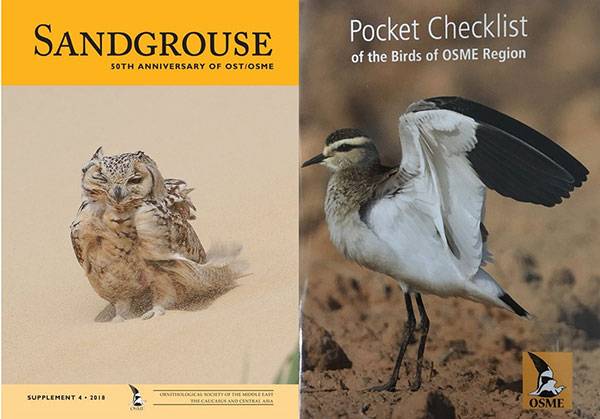
The year 2018 was a hugely significant one for OSME as we celebrated our 50th anniversary. In 1968, The Ornithological Society of Turkey (OST) was launched, and in 1978 its geographical remit expanded and became the Ornithological Society of the Middle East, with the addition of The Caucasus and Central Asia in 2001. During the year we celebrated this milestone in a number of ways. We produced a special Sandgrouse Supplement (4) to showcase the history and diversity of this fascinating region, as well as a special edition Pocket Checklist. Both publications went down very well with members and non-members alike and we were delighted to get lots of positive feedback.
A key project for us over the last few years has been the production of an Arabic version of the Field Guide to the Birds of the Middle East. This was a two stage process with the publication of the printed version in 2017 followed by the launch of a free to download smartphone App version during 2018. In April 2018 we launched the Apple version of the App, and then by the end of the year we were in the final testing phase of the Android version, which was subsequently released in January 2019. Making the App version free to download was a key requirement of OSME Council as we really want to see this used to grow interest in birds and their conservation across the Middle East. The number of downloads has now reached several thousand and our aim is to reach at least 10,000 by the end of 2019. You can read more about the App project, including partners and funders, here.
An assessment of the extent of illegal bird killing in the Arabian Peninsula, Iran and Iraq has been a major project for OSME working jointly with BirdLife International. During 2018 we reached the final stages of the project and a scientific research paper is due imminently. A presentation of the preliminary results was given at the Global Flyways Summit held in the UAE in April, this was followed by a workshop where a number of ideas were put forward to help tackle illegal bird killing. This has been a challenging project involved numerous stakeholders, government agencies and OSME members. We hope that the results will set a baseline against which future conservation efforts can be assessed, but also to act as a catalyst for future initiatives to combat illegal killing in the region.
In November, OSME Council member, Tomas Haraldsson, was appointed our first Youth Development Officer to build on the ‘bird camp’ initiative that he has been instrumental in trialling in recent years. Developing the bird-watchers of tomorrow and inspiring the next generation about bird conservation is becoming a key focus for OSME. There were two main activities during 2018:
- At Besh Barmag, Azerbaijan, a complete autumn (1 Sept – 7 Dec) of migration counts was organized and can be partly considered as an extension to the bird camps that were held at that site in 2016-2017. Nature Friends Azerbaijan, a local NGO, was instrumental in organising the camp and identifying participants. OSME co-funded the Besh Barmag bird camp and also invited four of the most active young Azeris to become OSME Supported Members. Two of the supported members have contributed guest blogs for the OSME website here and here.
- At Ras al-Maten, Lebanon, Tomas helped arrange the first Bird Camp outside Azerbaijan. During 1-4 October Swedish and Lebanese youth undertook a series of activities including bird migration studies, bird ringing and seminars. This bird camp was supported by the local BirdLife partner, SPNL, and we are already working on arrangements for follow up camps in Lebanon. OSME co-funded the camp through the Conservation Fund. A guest blog on the Lebanon bird camp can be found here.

The Conservation Fund which is OSME’s small grants programme saw a record level of expenditure during 2018, with a wide-range of projects supported as follows:
- Sociable Lapwing protection and awareness raising at Talimarzhan, Uzbekistan: £2000
- Bird surveys of the Bamyan Plateau, Afghanistan: £1000
- Status of scavenger birds, Kyrgyzstan: £2222
- Birds of the Anatolian Sweetgum Forests, Turkey: £1000
- Status of the Syrian Serin in Syria: £1900
- Supporting the Vulture Awareness Day on Socotra, Yemen: £500
- Developing a bird migration camp in Lebanon: £1750
- The Besh Barmag bird migration camp, Azerbaijan: £2000
- A study of the Imperial Eagle in Turkey: £2000
- White-headed duck surveys in Armenia: £1977
- Monitoring Sociable Lapwing at Manych wetlands, SW Russia: £1000
The total amount allocated to the 11 projects was £17,349 compared to £15,792 in 2017, which is the 4th year in a row we’ve committed records levels of funding to projects across the OSME region. Thanks to the independent Conservation Fund committee of Maxim Koshkin (Chairman), Richard Porter, Nabegh Ghazal Asswad, Sharif Jbour and Mick Green who assess all the applications and make recommendations to OSME Council for final approval.
Financially OSME had an exceptional 2018, our accounts are yet to be professionally reviewed before their presentation at our Summer Meeting at the end of June, but there are some notable highlights:
- Our income exceeded ninety thousand pounds significantly ahead of any previous year.
- Our subscription revenue remained stable but donations and the consequential Gift Aid increased dramatically. This feels like a strong indicator of the impact we are having with donors, funders and supporters who seem to be increasingly appreciative of our objectives, achievements and effectiveness.
- Expenditure was also at a record high with the fully funding of the Birds of the Middle East App, a record Conservation Fund Spend, the production of our Anniversary Sandgrouse and Checklist and the investment of a considerably enhanced presence at Birdfair.
We ended the year with reserves and commitments in place that will allow this pace of development to continue with a planned further record conservation spend in 2019 and other exciting developments to further benefit the birds of the OSME Region.
Our Summer Meeting and AGM was again held at the BTO Head Office in Thetford, and Richard Porter opened proceedings with a fascinating overview of the history of OSME, right from the very first meetings of the OST up to the modern day. Georgia Locock then gave a very personal perspective on the issue of illegal bird killing in Cyprus. Conservation in the Iraq Marshes by Nadheer Fazaa and an illustrated talk on birdwatching in Iran by Steve Rooke made for a hugely informative series of talks. At the Summer Meeting, to recognise Richard Porter’s massive contribution to both OSME and ornithology in the Middle East, Council announced that he would be the Society’s second Honorary Life Fellow. You can hear more from Richard and other attendees of the Summer Meeting thanks to a wonderful series of short interviews captured by Charlie Moores via a Sound Approach podcast – see episode 19.

We marked our 50th anniversary year at the UK Birdfair with a new modern stand design with a focus on displaying the smartphone App version of the Arabic Birds of the Middle East. The expanded stand was a great success and we held two well attended cake cutting ceremonies on the Saturday and Sunday with Chris Packham and David Lindo. This was a great opportunity to share some of our ongoing projects that have been the target for the 50th Anniversary – the smartphone App and the review of illegal bird killing in the Arabian Peninsula, Iran and Iraq. Feedback from OSME members and visitors to our Birdfair stand was overwhelmingly positive and Council recently decided to continue with the new design at the 2019 Birdfair.
During 2018 OSME continued to steadily grow our social media presence with more than 4000 followers on Twitter and almost 2000 likes on our Facebook page. We’ve been actively promoting bird watching and conservation across the region through regular blogs on our website. Richard Porter has been co-ordinating contributions through regular guest blogs. We also tried several articles that had both English and local language versions – these were particularly successful and helped reached new audiences. Offers of guest blogs are always welcome so please contact us if you would like to discuss a possible contribution.
All members receive two issues of Sandgrouse each year and Volume 40 (2018) saw the continued publication of our highly regarded journal. Peter Cowan, the Editorial team and Swallowtail Print do a fabulous job in producing Sandgrouse which is reflected in the numerous positive comments I receive about the journal. To celebrate the 50th anniversary of its formation OSME also produced a special Sandgrouse Supplement (4) to showcase the history and diversity of this fascinating region, as well as a special edition Pocket Checklist.

Some thoughts on the year ahead
A key objective for 2019 will be to continue to grow our small grants programme and deliver another record level of expenditure through our Conservation Fund. The threats to birds and their habitats are not going away and OSME are determined to do all we can to support research and conservation projects across the region. This year we’ll be announcing a new and exciting fund that will be specifically aimed at those bird species that are categorised as globally threatened by IUCN/BirdLife International.
Our focus on youth development and education will continue to grow throughout the year spearheaded by our newly appointed Youth Development Officer, Tomas Haraldsson. A number of new initiatives are in the pipeline that we hope to announce in the coming months.
OSME are considering the development of a digital version of Sandgrouse that will be available to members as an additional benefit or an alternative to receiving a paper copy of the journal. A trial issue will be produced during the year before we take a decision whether to role this out as a standard part of OSME membership.
The final results of the assessment of illegal bird killing in the Arabian Peninsula, Iraq and Iran will be published imminently as a special on-line Sandgouse manuscript. A key challenge for OSME, working with BirdLife International and many other organisations and individuals, is how we can make a positive difference and see a much needed reduction in the number of birds illegally killed. Such change will be a long term process and we see opportunities to join up the various strands of OSME’s work – the free to download Arabic App of Birds of the Middle East, an increased focus on youth development and education, and our small grants programme, all have a positive role to play in tackling illegal bird killing.
Finally on behalf of OSME Council, a huge thanks to all OSME members and supporters who continue to contribute to the work of OSME in numerous ways.
Thoughts and comments welcome via chairman@osme.org
Dr Rob Sheldon, Chairman, OSME
